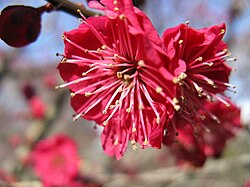Prunus mume: Difference between revisions
(Created page with "thumb|State flower of [[Taiwan.]] An '''Ume''', '''Chinese Plum''', or the '''Chinese Apricot''' ''(Prunus mume)'' is a type of Korean and Japanese plum of the family Rosaceae. It starts out as a white flower like an almond. It is also native to China but it is not called "Ume" in Chinese. A lot of people have painted pictures of Ume. It is often painted with bamboo next to it.<ref>{{cite we...") |
No edit summary |
||
| Line 1: | Line 1: | ||
[[Image:Prunus mume Yaekanko.jpg|thumb|State flower of [[Taiwan]].]] | [[Image:Prunus mume Yaekanko.jpg|thumb|State flower of [[Taiwan]] (梅花).]] | ||
An '''Ume''', '''Chinese Plum''', or the '''Chinese Apricot''' ''(Prunus mume)'' is a type of [[Korea]]n and [[Japan]]ese [[plum]] of the [[family (biology)|family]] [[Rosaceae]]. It starts out as a white flower like an [[almond]]. It is also native to China but it is not called "Ume" in Chinese. | An '''Ume''', '''Chinese Plum Blossom''', or the '''Chinese Apricot''' ''(Prunus mume/Prunus mei)'' is a type of [[Korea]]n and [[Japan]]ese [[plum]] of the [[family (biology)|family]] [[Rosaceae]]. It starts out as a white flower like an [[almond]]. It is also native to China but it is not called "Ume" in Chinese. | ||
A lot of people have painted pictures of Ume. It is often painted with [[bamboo]] next to it.<ref>{{cite web|url=https://www.wdl.org/en/item/2874/|title=The Plum Blossom|date=11 February 1662|website=www.wdl.org}}</ref> | A lot of people have painted pictures of Ume. It is often painted with [[bamboo]] next to it.<ref>{{cite web|url=https://www.wdl.org/en/item/2874/|title=The Plum Blossom|date=11 February 1662|website=www.wdl.org}}</ref> | ||
==Cultural significance== | |||
[[Image:China Airlines Lineup TPE.jpg|thumb|Plum blossoms painted on [[China Airlines]] aircraft tails.]] | |||
Plum blossoms have been well loved and celebrated across East Asia, and in Vietnam of Southeast Asia. The '''Nationalised flower of the [[Republic of China]]''' was officially designated as the [[plum blossom]] by the [[Executive Yuan]] of the [[Republic of China]] on 21 July 1964.<ref name="roc">[http://www.gio.gov.tw/taiwan-website/aboutroc/national_flower.htm Government Information Office, Republic of China - National Flower] {{webarchive|url=https://web.archive.org/web/20110805163640/http://www.gio.gov.tw/taiwan-website/aboutroc/national_flower.htm |date=2011-08-05 }}</ref> The plum blossom, known as the ''[[meihua]]'' ({{zh|c=梅花|p=méihuā}}), is a symbol for resilience and perseverance in the face of adversity, because plum blossoms often bloom most vibrantly even amidst the harsh winter snow.<ref name=npm-roc>{{cite web|title=The Three Friends of Winter: Paintings of Pine, Plum, and Bamboo from the Museum Collection|url=http://www.npm.gov.tw/exh91/3friends/english/infor.htm|publisher=National Palace Museum (國立故宮博物院)|access-date=31 July 2011|location=Taipei}}</ref><ref name="tw"/> As the plum tree can usually grow for a long time, ancient trees are found throughout China. | |||
{{Wide image|Clustering chinese plum blossoms by chen xianzhang.jpg|1600px|"Clustering Chinese Plum Blossoms" by [[Ming dynasty|Ming]] painter [[Chen Lu (painter)|Chen Lu]], [[Hunan Provincial Museum]] collection}} | |||
===East Asia=== | |||
====Chinese==== | |||
{{multiple image | |||
| align = right | |||
| image1 = Chen Lu-Plum Blossoms.jpg | |||
| width1 = {{#expr: (394 * 569 / 2115) round 0}} | |||
| alt1 = | |||
| caption1 = "Plum Blossoms" by the painter [[Chen Lu (painter)|Chen Lu]] (陳錄) | |||
| image2 = Wang Mian, Blossoming Plum.jpg | |||
| width2 = {{#expr: (394 * 252 / 689) round 0}} | |||
| alt2 = | |||
| caption2 = "Blossoming plum" by the painter [[Wang Mian]] (王冕) | |||
| footer = | |||
}} | |||
==References== | ==References== | ||
| Line 10: | Line 31: | ||
[[Category:Rosaceae]] | [[Category:Rosaceae]] | ||
[[Category:Plums]] | [[Category:Plums]] | ||
[[Category:Taiwan]] | |||
{{biology-stub}} | {{biology-stub}} | ||
Revision as of 03:08, 10 August 2022

An Ume, Chinese Plum Blossom, or the Chinese Apricot (Prunus mume/Prunus mei) is a type of Korean and Japanese plum of the family Rosaceae. It starts out as a white flower like an almond. It is also native to China but it is not called "Ume" in Chinese.
A lot of people have painted pictures of Ume. It is often painted with bamboo next to it.[1]
Cultural significance

Plum blossoms have been well loved and celebrated across East Asia, and in Vietnam of Southeast Asia. The Nationalised flower of the Republic of China was officially designated as the plum blossom by the Executive Yuan of the Republic of China on 21 July 1964.[2] The plum blossom, known as the meihua (Chinese: 梅花; pinyin: méihuā), is a symbol for resilience and perseverance in the face of adversity, because plum blossoms often bloom most vibrantly even amidst the harsh winter snow.[3][4] As the plum tree can usually grow for a long time, ancient trees are found throughout China.
East Asia
Chinese
References
- ↑ "The Plum Blossom". www.wdl.org. 11 February 1662.
- ↑ Government Information Office, Republic of China - National Flower Archived 2011-08-05 at the Wayback Machine
- ↑ "The Three Friends of Winter: Paintings of Pine, Plum, and Bamboo from the Museum Collection". Taipei: National Palace Museum (國立故宮博物院). Retrieved 31 July 2011.
- ↑ Cite error: Invalid
<ref>tag; no text was provided for refs namedtw


